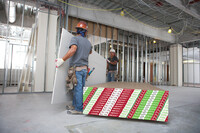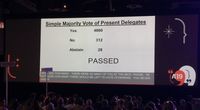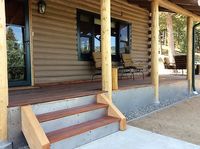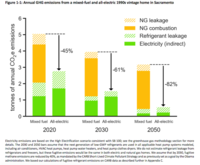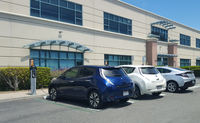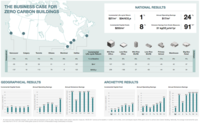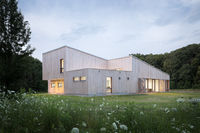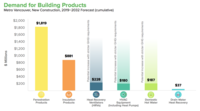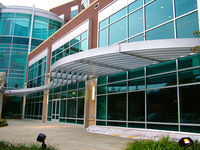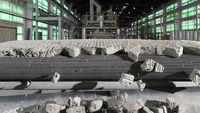Product Review
USG’s EcoSmart gypsum panels make it easier to lower a building’s overall carbon footprint while saving water as well.
It is hard to turn on the news without seeing warnings about rising greenhouse gas concentrations in the atmosphere and how time is running out for action. Design teams trying to lower their building materials’ carbon footprint usually look at reducing the amount of known high emitters, such as steel and concrete. But heavy interior products... Read more
News Brief
The resolution calls for big changes in how AIA and its members will approach the climate crisis.
The American Institute of Architects (AIA) has adopted the AIA Resolution for Urgent and Sustained Climate Action. The historic resolution passed 4,860 to 312 at the 2019 AIA National Convention in Las Vegas.
“Be it resolved that, commencing in 2019 and continuing until zero-net carbon practice is the accepted standard of its members,... Read more
News Analysis
Resilient design is all very well for new construction, but how do we deal with billions of square feet of existing building stock?
Resilience, the ability of a building to remain functional or recover quickly after a major disruption, is becoming a more common consideration when designing new structures. Unfortunately, it’s too late for millions of buildings that are already in harm’s way. Or is it?
With some notable exceptions, retrofitting buildings for... Read more
Op-Ed
The A&D community’s “ask” for ingredient reporting continues to move entire industries toward healthier products, especially now with the Supplier HPD.
By Wendy Vittori
“Ask for transparency.” Over the past decade, the material health and transparency movement has demonstrated that ingredient suppliers, product manufacturers, architects, designers, contractors, and owners can work together to make ingredient transparency the norm in the building industry.
The market speaksIt... Read more
News Brief
Electrifying homes could reduce greenhouse gas emissions 90% by 2050.
Switching California homes from natural gas to electricity for space heating, water heating, and clothes drying is a cost-effective way to drastically reduce greenhouse gas (GHG) emissions, according to a new study conducted by Energy and Environmental Economics (E3). Natural gas—accounting for both burning and leakage—is currently responsible... Read more
Product Review
EV charging stations are becoming mainstream, but the technology interface and installation are still developing.
Carbon dioxide concentrations in the atmosphere just reached the highest levels in human history, and our gas-guzzling transportation industry—the United States’ largest greenhouse gas emitter—is partially to blame. Minimizing these transportation impacts to and from our green buildings should be a priority, and encouraging the use of plug-in... Read more
News Analysis
Several organizations have already committed to piloting the new program, which aims to streamline documentation and auditing.
When you think of the Living Building Challenge (LBC), what image pops into your head? A nature center, perhaps, or the headquarters of an environmental nonprofit? Probably not a bus station—but that could change in the near future.
The new volume program offered by the International Living Future Institute (ILFI)—a way of certifying... Read more
News Brief
The newly released HPD version 2.2 integrates reporting options for suppliers of parts that go into building products, and for managing multiple versions of a product.
It would seem at first glance like a simple proposition: provide a standard format for reporting on the contents of a building product or material. Like anything in real life, however, as you look more closely, you discover that it’s not so simple.
That dynamic explains the development of the Health Product Declaration, which has... Read more
News Brief
New buildings with net-zero-carbon operations will provide a 1% return over 25 years, says a new study.
Decarbonization of the building sector is vital to countries striving to dramatically cut their greenhouse gas (GHG) emissions by 2050. But might there be less altruistic reasons to pursue net-zero carbon? A recent study, Making the Case for Building to Zero Carbon, says yes.
Commissioned by the Canada Green Building Council (CaGBC) and... Read more
Webcast
In this on-demand webcast on the sustainability of wood construction, we tap the expertise of leaders in the field and look into three main issues:
The importance of certification The complex issue of embodied carbon Wood legality: a new LEED pilot credit Speakers: Corey Brinkema of the Forest Stewardship Council; Kate Simonen,... Read moreNews Brief
Environmental groups including the Forest Stewardship Council have gotten together to support better forestry practices.
Mass timber construction is gaining ground in North America, with the frequent justification that it reduces embodied carbon (the upfront greenhouse gas emissions associated with manufacture and transportation of materials) when compared with concrete or steel. But not all wood products are created equal when it comes to carbon emissions,... Read more
Feature
Colleges and universities are increasingly turning to Passive House for its energy, carbon, and comfort benefits. But getting the details right isn’t easy.
Passive House has graduated—and it’s going off to college.
Created in the early 1990s, Passive House started out as a standard for certifying single-family homes. It had three core requirements having to do with modeled heating and cooling demands, modeled total energy demand, and actual airtightness verified by a blower-door test. The... Read more
News Brief
A product-demand forecasting model for Metro Vancouver uses British Columbia’s Energy Step Code to predict future demand that suppliers can bank on.
If you’re selling run-of-the-mill double-pane windows in the Greater Vancouver market in Canada, it’s time to start retooling your production lines, according to a new study by the Vancouver Economic Commission. Demand for those windows will drop by 2022 and vanish by 2027, according to the study, which tracks the implementation dates for... Read more
Spotlight Report
Passive House has graduated—and it’s going off to college. Over the years, the original Passive House Institute (PHI) certification system has branched out considerably to offer different requirements for different building types, such as offices, hospitals, schools—even swimming pools. There’s also a considerably different standard in the U.S... Read more
Product Review
With the PVDF coating Fluropon Pure, “fluorinated” does not necessarily mean persistent, bioaccumulative, and toxic, but it does have a complicated environmental profile.
Metal coatings have a difficult job. When used on building exteriors, such as for cladding, they have to last decades, protecting the metal against oxidation. They also have to resist damage from abrasion, temperature extremes, dirt, acidic urban conditions, moisture, and ultraviolet light—all while maintaining color and gloss. Combining all... Read more
News Brief
The latest version of LBC adds flexibility to materials and water requirements, while Core meets a separate market need.
The International Living Future Institute (ILFI) has announced updates to its stringent Living Building Challenge (LBC) standard as well as the rollout of a new, related certification called Core. With Core, ILFI moves into the previously taboo realm of rewarding relative improvements (as opposed to absolute achievements, like net-positive... Read more
News Analysis
The 2019 winners of AIA’s COTE Top Ten are all about education and connection to place.
There is a bittersweet irony in celebrating a sustainable design award for the renovation of a major cathedral a mere week after Notre-Dame de Paris was devastated by a fire that was started, according to initial reports, by renovation activities.
St. Patrick’s Cathedral in New York City sees about... Read more
News Brief
An ambitious new law makes progress towards NYC’s goal of 80% carbon reduction by 2050 by setting aggressive carbon emission limits for nearly all NYC buildings over 25,000 square feet.
The limits are aggressive—no one argues with that. A sweeping new law—the most ambitious in the world for any large city—forces owners of almost every large building in New York City to drastically limit carbon emissions or pay an annual fine, starting in 2024, of $268 per metric ton of CO2 over the limit. The buildings covered by the law will... Read more
Product Review
Foam glass aggregate made from post-consumer recycled glass bottles can replace both foam insulation and aggregate below grade.
Extruded polystyrene’s (XPS) high R-value and water resistance have made it the default insulation for below-grade applications, but its petroleum-based styrene chemistry, inherent flammability, and high-global-warming-potential (GWP) blowing agents make these board products less than desirable environmental choices. And although high-density... Read more
News Brief
Timber Traceability is one group’s answer to the controversial Legal Wood pilot path.
Who’s in favor of legally sourced wood?
If you’re raising your hand, you’re not alone: illegal logging is a global scourge that destroys ecosystems and contributes to climate change. It’s carried out by organized crime, and is used to fund civil wars and terrorism. And by some estimates, as much as half the timber in the world is... Read more

